“But in the anxiety of the second half of the eighteenth century, the fear of madness grew at the same time as the dread of unreason: and thereby the two forms of obsession, leaning upon each other, continued to reinforce each other. And at the very moment we note the liberation of the iconographic powers that accompany unreason, we hear on all sides complaints about the ravages of madness. Already we are familiar with the concern generated by “nervous diseases,” and the awareness that man becomes more deli-cate in proportion as he perfects himself. As the century advanced, the concern became more pressing, the warnings more solemn.” ( Foucault )
Most of the romantics who wrote about insanity preferred playing a kind of cat-and-mouse game with it. “I have pray’d/ For madness as a blessing,” Byron says, speaking through the mask of the melancholy “Manfred”; though one of the sanest men who ever lived, he was not averse to giving the impression that he was “Mad, bad and dangerous to know” , as Lady Caroline Lamb was delighted to attest. It was the “otherness” of madness and its proximity that attracted yet repulsed; a curiosity with the rigorous geometry of desire.
Such literary posturings sometimes led to a denouement where real madness took over from the simulated kind. Only rarely, however, does anyone give us an insider’s view of insanity; perhaps because it is so difficult to write coherently without incoherence. The one romantic writer who speaks eloquently and from personal experience about what it actually means to go mad is Géreard de Nerval, who manages to be poetic and explicit about his psychotic interludes.

"Büchner died of typhus in 1837 at the age of twenty-three, leaving behind a small but exceptional trove of dramatic literature: DANTON’S DEATH (1835); LEONCE AND LENA (1836); and WOYZECK (1836). He also published one novella, LENZ (1836), and a prominent revolutionary political pamphlet, THE HESSIAN MESSENGER (1835). Stimulated by the then-liberal Enlightenment conception of individual rights and freedoms, Büchner started an underground revolutionary group called the Society for the Rights of Man. Through his work with this group, he wrote an inflammatory pamphlet "The Hessian Courier," which has been called a precursor to the Communist Manifesto. The pamphlet was written to encourage the peasantry to rise up against the oppressive Hessian government."
Nerval was thirty-three when he suffered his first severe attack of hallucinations in 1841. One evening as he was walking through Paris he felt himself magically attracted by an eastern star. As its magnetism drew him onward he began shedding his “terrestrial garments” and scattering them on the sidewalk. ” The roadway seemed to lead continually upwards and the star to grow bigger,” he writes in “Aurelia”. “Then I stood still, my arms outstretched, waiting for the moment when my soul should break free from my body, attracted magnetically by the rays of the star. A shudder went through me. Regret for the earth and for those I loved there gripped my heart, and so ardently within myself did I beseech the Spirit drawing me up towards it that it seemed as if I went down again among men. A night patrol surrounded me.”
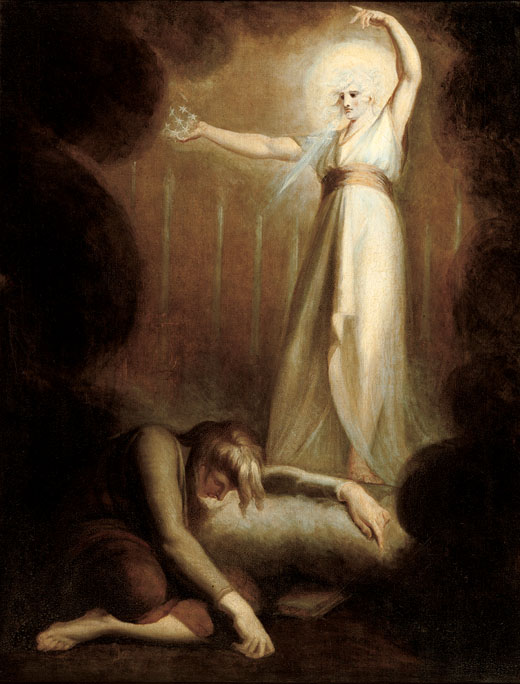
Fuseli. St-John with Seven Candlesticks. "The only man that ever I knew Who did not make me almost spew Was Fuseli: he was both Turk and Jew - And so, dear Christian Friends, how do you do?" (William Blake's tribute to Fuseli)
He spent the night in jail, still hallucinating. Friends came to fetch him in the morning, and he was transferred to a private clinic, where the visions continued for many weeks. The continents opened up before him; he saw to the ends of the earth,” beyond the Mountains of the Moon and ancient Ethiopia,” to Granada and the banks of the Rhine, but “Everywhere the suffering image of the eternal Mother was dying, weeping, or languishing.” It occurred to him, then, that he was embarked on the kind of spiritual journey which the ancients must have regarded as a descent into hell.
…Already Raulin had observed that “since the birth of medicine . . . these illnesses have multiplied, have become more dangerous, more complicated, more prob-lematical and difficult to cure.” By Tissot’s time, this general impression became a firm belief, a sort of medical dogma: nervous diseases “were formerly much less fre-quent than they are nowadays; and this for two reasons: one, that men were in general more robust, and less frequently ill; there were fewer diseases of any kind; the other, that the causes which produce nervous diseases in especial have multiplied in a greater proportion, in recent times, than the other general causes of illness, some of which even seem to have diminished. … I do not hesitate to say that if they were once the rarest, they are today the most frequent.” And soon men regained that awareness, which had been so intense in the sixteenth century, of the precariousness of a reason that can at any moment be compromised, and definitively, by madness. ( Focault )
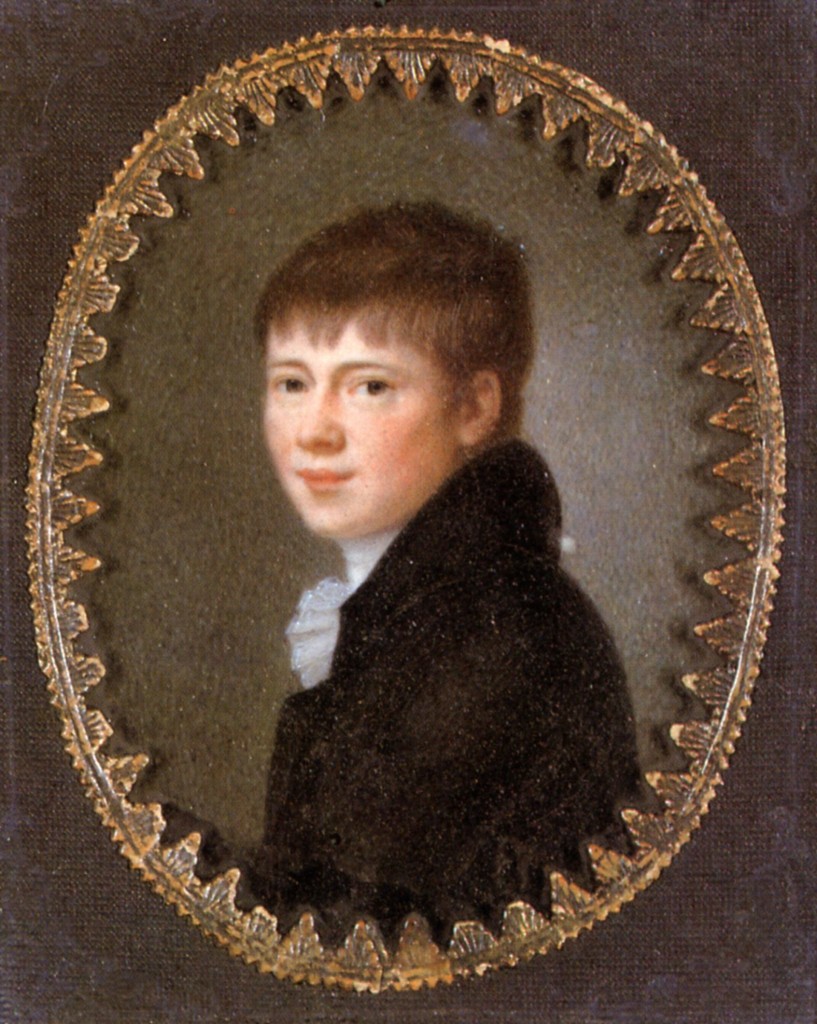
Heinrich von Kleist, whose portrait this is, was the wild man of German romantic poetry. In 1808 he wrote a play about a murderous bride; three years later, at the age of thirty-four, he proceeded to kill both his mistress and himself.
v>
After eight months his visions had subsided and Nerval seemed cured. He recovered sufficiently to make a journey to the Near East, but there were to be further schizophrenic episodes, and he committed suicide in 1855. According to his doctor, Emile Blanche, “Gérard de Nerval hanged himself because he saw his madness face to face.”
At least his insanity seems to have been no impediment to his poetry; on the contrary, it led him to that curious concept, “supernaturalisme”, which was to exert a powerful influence on the surrealist poets. T.S. Eliot acknowledged another sort of debt when he quoted from him in “The Waste Land” – the desolate lines in which Nerval describes himself as “El desdichado,” a man abandoned by fate, “Le prince d’Aquitaine a la tour abolie.” In the same poem Nerval speaks of the “black sun” of his melancholia, and yet, precisely like an exiled prince, he takes a certain defiant pride in his outcast state. Madness, he suggests, is a gift that is not to be taken lightly, since it leads to the liberation of the poet’s second sight.
This is very close to Georg Buchner’s view of insanity as an ecstatic dance of freedom that mimes man’s revolt against the restraints of civilization. Buchner’s madmen are heroes, not villains, and their actions anticipate R.D. Laing’s contention that madness is often nothing more than a desperate bid for liberty. The title role for Buchner’s play “Woyzeck”, sometimes known in Alban Berg’s operatic version “Wozzeck” , presents a case in point, where madness is the only possible solution to an otherwise insoluble problem.
“What the classical period had confined was not only an abstract unreason which mingled madmen and libertines, invalids, and criminals, but also an enormous reservoir of the fantastic, a dormant world of monsters supposedly en-gulfed in the darkness of
Hieronymus Bosch which had once spewed them forth. One might say that the fortresses of confinement added to their social role of segregation and purification a quite opposite cultural function. Even as they separated reason from unreason on society’s surface,
they preserved in depth the images where they mingled and ex-changed properties.
The fortresses of confinement func-tioned as a great, long silent memory; they maintained in the shadows an iconographic power that men might have thought was exorcised; created by the new classical order, they preserved, against it and against time, forbidden fig-ures that could thus be transmitted intact from the six-teenth to the nineteenth century. In this abolished time, the Brocken joined Dulle Griet in the same imaginary land-scape, and Noirceuil, the great legend of the Marechal de Rais. Confinement allowed, indeed called for, this resistance of imagery. ( Foucault )
And Buchner’s “Lenz” – perhaps the finest short story in the German language, certainly of the romantic century- is one great, never-ending mad scene. It is based on the life of the young poet Reinhold Lenz, a close friend of Goethe’s, who lived in a mountain village under a clergyman’s care while slowly going mad. No one, not even Nerval, has succeeded as well as Buchner in capturing the terrible tension and impatience of insanity:
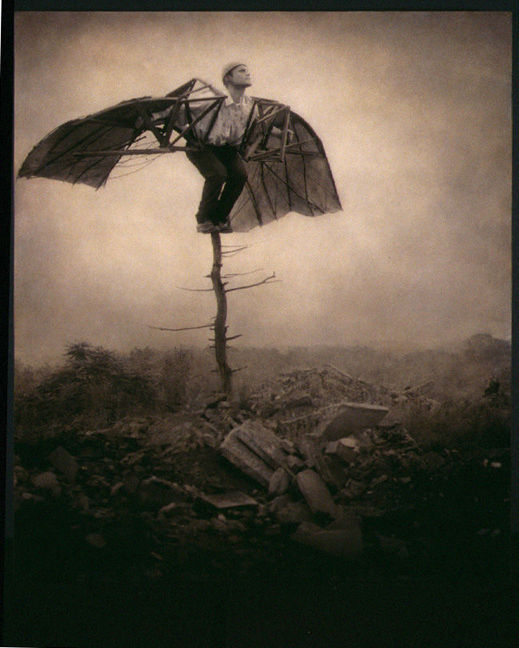
"Robert Parke-Harrison collaborates with his wife, Shana to create a group of photographs that invoked a feeling of great loneliness in me. Parke-Harrison is in the photos himself as “Everyman” in a commentary on what we are doing to our earth. The couple use paper negatives and collage to create the sad tales they depict. We see nature being domesticated and controlled. We see nature disappearing with barrenness left behind. At the same time these photos are beautiful, breathtaking, and melancholy."
“…as evening came on he was overcome by a strange anxiety, he felt he wanted to run after the sun. As his surrounding gre darker in shadow, everything seemed dreamlike to him, repugnant; anxiety took hold of him like a child who must sleep in the dark; he felt as if he were blind. An now it grew, this mountain of madness shot up at his feet; the hopeless thought that everything was a dream spread itself out in front of him; he clung to all solid objects. Figures rapidly passed him by, he pressed toward them; they were shadows, life withdrew from him, his limbs were numb. He spoke, he sang, he recited passages from Shakespeare, he grasped at everything that might make his blood flow faster, he tried everything, but- he was cold, cold! “
Also interesting is that how Buchner presents nature as a destabilising and oppressive force, something diametrically opposite to the romantics, or even the nature descriptions in Goethe’s Young Werther. The story also touches on an interesting philosophical debate surrounding an aesthetic issue. Lenz is vehemently critical of idealists and thinks that only simple mimetic representational role of art is valuable:

" At the heart of these pictorial tales is a lone individual—ParkeHarrison himself as “Everyman”—engaged in Herculean struggles with nature and artifice. The mythic world he creates mirrors our world, where nature is domesticated and controlled. In actions that are both humorously metaphorical and lyrically poetic, ParkeHarrison constructs beguiling stories that make us consider what we have done or are doing to our earth."
He said: God has created the world the way it should be, and we cannot cobble together anything better, we should just try to copy it as best we can. I demand in all things – life, the possibility of existence, and then all is well. There is then no point in asking whether something is beautiful or ugly; the feeling that something has been created possesses life stands above these qualities and is the only criterion in the matters of art. Besides, this is quite a rarity; you can find it in Shakespeare, and we encounter it totally in folk-songs and sometimes in Goethe. All the rest can be thrown in the fire.
It is interesting because the story itself is far from a representation of the objective world. Indeed, one of the sources of Lenz’s madness is that he is not able to extricate his own consciousness from that of the outside world and that he thinks the whole world is just a figment of his imagination and extension of his own mind.
…”But the images liberated at the end of the eighteenth century were not identical at all points with those the seventeenth century had tried to eliminate. Something had happened, in the darkness, which detached them from that secret world where the
Renaissance, after the Middle Ages, had found them; they had lodged in the hearts, in the de-sires, in the imaginations of men; and instead of manifesting to sight the abrupt presence of the insane, they seethed as the strange contradiction of human appetites: the complicity of desire and murder, of cruelty and the longing to suffer, of sovereignty and slavery, of insult and humiliation. The great cosmic conflict whose peripities had been revealed by the Insane in the fifteenth and sixteenth cen-turies, shifted until it became, at the end of the classical period, a dialectic lacking the heart’s mediation.” … ( Foucault )
As a sustained exploration of madness in literature, Buchner’s “Lenz” is eclipsed only by an American novel that deals with insanity on the sea rather than in the mountains and has the hero’s blood running hot rather than cold when the lunacy is upon him:

"This classic story by Herman Melville revolves around Captain Ahab and his obsession with a huge whale, Moby Dick. The whale caused the loss of Ahab's leg years before, leaving Ahab to stomp the boards of his ship on a peg leg. Ahab is so crazed by his desire to kill the whale, that he is prepared to sacrifice everything, including his life, the lives of his crew members, and even his ship to find and destroy his nemesis, Moby Dick."
“Often, when forced from his hammock by exhausting and intolerably vivid dreams of the night, which, resuming his own intense thoughts through the day, carried them on amid a clashing of phrensies, and whirled them round and round and round in his blazing brain, till the very throbbing of his life-spot became insufferable anguish; and when, as was sometimes the case, these spiritual throes in him heaved his being up from its base, and a chasm seemed opening in him, from which forked flames and lightnings shot up, and accursed fiends beckoned him to leap down among them; when this hell in himself yawned beneath him, a wild cry would be heard through the ship; and with glaring eyes Ahab would burst from his state room, as though escaping from a bed that was on fire.”
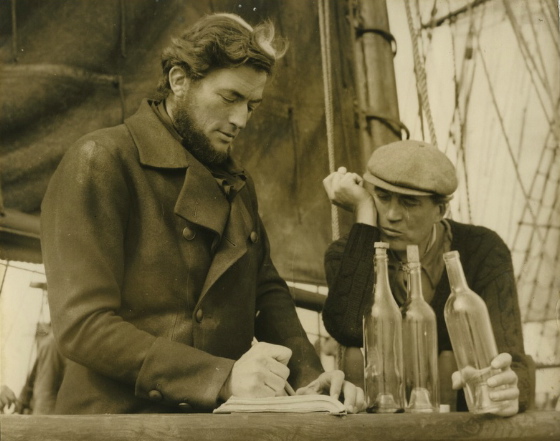
"MOBY DICK The John Huston version with Gregory Peck. When I looked at the poster and the lobby cards outside the theater before going in I wondered if the film could possibly deliver the spectacle it promised. It did -- beyond my wildest anticipation."
Charles Reade was a popular novelist in the Victorian era. In 1863 he published Hard Cash in which he depicted how easily sane people could be committed to lunatic asylums. The threat of wrongful confinement was an abiding Victorian fear and his novel created much debate amongst the public when it appeared.In Hard Cash, Mr Hardy arranges with asylum doctors to have his son, Alfred, committed to an asylum although he is perfectly sane. The novel portrays the asylum as a place of excessive cruelty and
ignorance and shows the difficulty Alfred has in obtaining his release. Eventually, he is set free and the asylum doctors are seen to be fools, motivated only by financial gain.
The leading asylum doctor in the novel is Dr Wycherley who represents a satiric portrait of Dr John Conolly: ”Dr Wycherley; bland and bald, with a fine head, and a face naturally intelligent, but crossed every now and then by gleams of vacancy; a man of large reading and tact to make it subserve his interests. A writer on certain medical subjects, he had so saturated himself with circumlocution, that it distilled from his very tongue”.
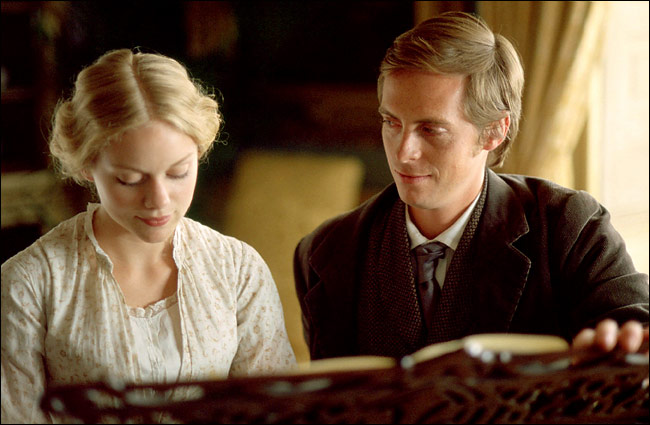
Christina Cole and Stephen Campbell Moore in a "Masterpiece Theater" version of Anthony Trollope's novel "He Knew He Was Right."
Dr Wycherley uses medical terminology to mask his ignorance and to bamboozle his patients. He declares Alfred Hardie to be suffering from ”Incubation of Insanity” without even examining him. Interestingly, despite the novel’s avowed social concerns, it portrays mad people in a very unsympathetic light. The mad are seen as animalistic, cowardly, morally suspect and ultimately irredeemable. A major thrust of the book is the sense of disgust and horror that the reader is expected to feel at the prospect of
being in the company of mad people – “the terror of a madhouse, which is natural to a sane man”. Alfred’s fellow inmates are described as follows:
“Here he was surrounded by the desperate order of maniacs he at present scarcely knew but by report. Throughout that awful night he could never close his eyes for the horrible unearthly sounds that assailed him. Singing, swearing, howling like wild beasts!… his
nose poisoned with ammoniacal vapours, and the peculiar wild beast smell that marks the true maniac.” In these images, we see that mad people are considered to have severed their connections with the rest of humanity. Reade repeatedly stresses the difference between the anonymous mass of almost subhuman asylum inmates and the novel’s hero, Alfred Hardie, the representative of sanity.For all his moral indignation against wrongful confinement, Reade presents a deeply conservative picture of madness and his images of bestiality look back to eighteenth-century century descriptions.
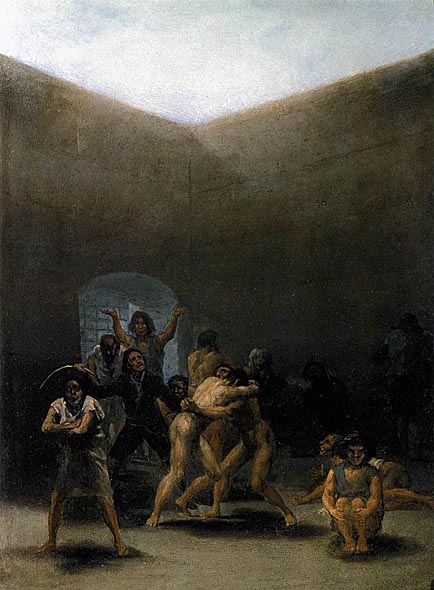
Goya. "The Madhouse and other small paintings now in the Academy, once thought to have been among the scenes of so-called national pastimes are now generally attributed to a considerably later date, for stylistic reasons. The Yard of a Madhouse is one of many scenes Goya recorded that he had actually witnessed, among them some of the war scenes in the Desastres (with the titles 'I saw this' and 'this too'). Many of his etchings and drawings testify to his concern for the plight of lunatics and prisoners throughout his life. See, for instance, the drawing of a madman behind bars made in Bordeaux."
“Sadism is not a name finally given to a practice as old as Eros; it is a massive cultural fact which appeared precisely at the end of the eighteenth century, and which constitutes one of the greatest conversions of Western imagination: unreason transformed into delirium of the heart, madness of desire, the insane dialogue of love and death in the limitless pre-sumption of appetite. Sadism appears at the very moment that unreason, confined for over a century and reduced to silence, reappears, no longer as an image of the world, no longer as a figura, but as language and desire. And it is no accident that sadism, as an individual phenomenon bearing the name of a man, was born of confinement and, within confinement, that Sade’s entire oeuvre is dominated by the images of the Fortress, the Cell, the Cellar, the Convent, the inaccessible Island which thus form, as it were, the natural habitat of unreason.
It is no accident, either, that all the fantastic literature of madness and horror, which is contemporary with Sade’s oeuvre, takes place, preferentially, in the strongholds of confinement. And this whole sudden conversion of Western memory at the end of the eighteenth century, with its possibility of rediscovering- deformed and endowed with a new meaning-figures fa-miliar at the end of the Middle Ages: was this conversion not authorized by the survival and the reawakening of the fantastic in the very places where unreason had been re-duced to silence? ( Foucault, Madness and Civilization )
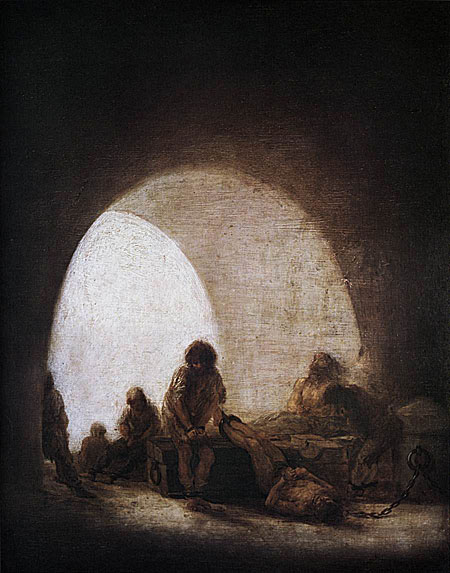
"A Prison Scene: 1810-14 This prison scene is related in style and character to a number of small paintings of war scenes and other subjects inspired by the Napoleonic invasion. Prisoners - not only prisoners of war - are among the victims of injustice and cruelty that figure in many of Goya's drawings and engravings. A garroted man is the subject of one of his earliest etchings and various other forms of punishment and torture are represented in later graphic works. Three etchings of about 1815 show chained and shackled prisoners very similar to those in the painting. This prison scene, executed with a minimum of colour, is remarkable for the atmosphere of gloom and the effect of anonymous suffering created by the lightly painted, indistinct figures in an enormous cavern-like setting."
…Yet fear and anxiety were not far off: in the reaction of confinement, they reappeared, doubled. People were once afraid, people were still afraid, of being confined; at the end of the eighteenth century, Sade was still haunted by fear of what he called “the black men” who lay in wait to put him away. But now the estate of confinement acquired its own powers; it became in its turn the birthplace of evil, and could henceforth spread that evil by itself instituting an-other reign of terror. Suddenly, in a few years in the middle of the eighteenth century, a fear arose-a fear formulated in medical terms but animated, basically, by a moral myth.
People were in dread of a mysterious disease that spread, it was said, from the houses of confinement and would soon threaten the cities. They spoke of prison fevers; they evoked the wag-ons of criminals, men in chains who passed through the cities, leaving disease in their wake; scurvy was thought to cause contagions; it was said that the air, tainted by disease, would corrupt the residential quarters. And the great image of medieval horror reappeared, giving birth, in the meta-phors of dread, to a second panic. The house of confine-ment was no longer only the lazar house at the city’s edge; it was leprosy itself confronting the town: “A terrible ul-cer upon the body.
“The correction ward is the place of great-est punishment for the House, containing when we visited it forty seven girls, most of them very young, more thoughtless than guilty. . . . And always this confusion of ages, this shocking mixture of frivolous girls with hardened women who can teach them only the art of the most un-bridled corruption.” For a long time these visions would prowl insistently through the nights of the eighteenth century. For a moment they would be picked out by the piti-less light of Sade’s work and placed by it in the rigorous geometry of Desire. They would be taken up again and wrapped in the murky light of Goya’s Madhouse, or the twilight that surrounds the Quinta del Sordo. How closely the faces of the Disparates resemble them! A whole imag-inary landscape reappears,conveyed by the Great Fear confinement now inspires. ( Foucault, Madness and Civilization )


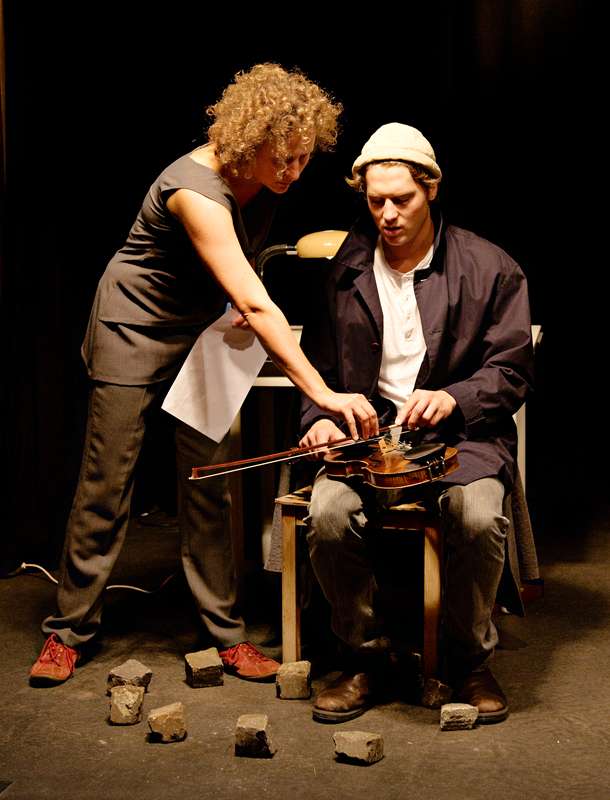


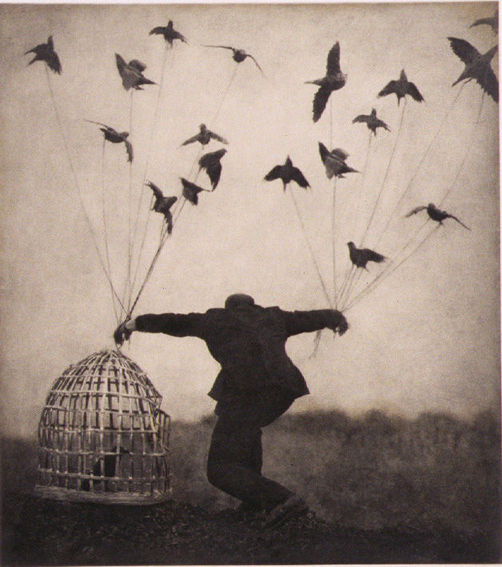

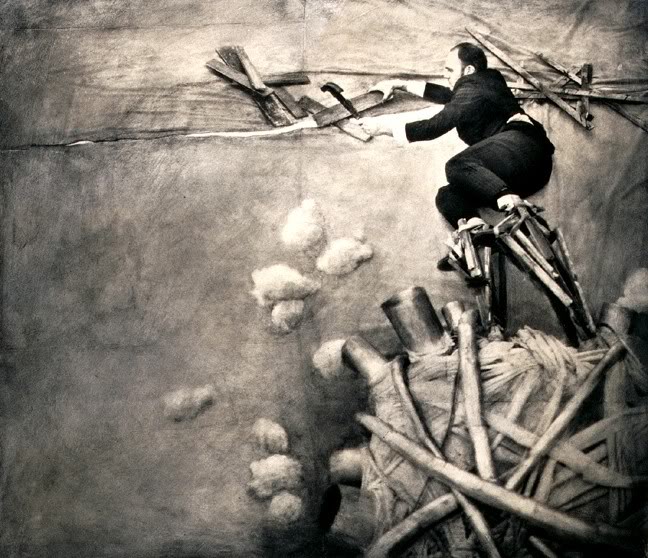




 COMMENTS
COMMENTS



